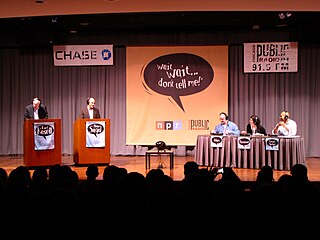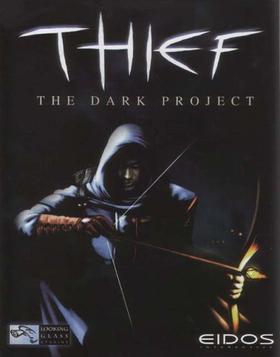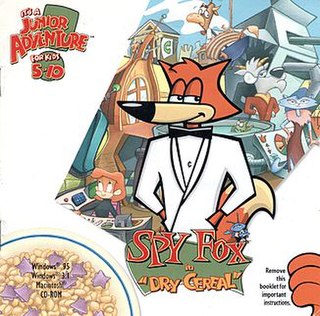
A panel show or panel game is a radio or television game show in which a panel of celebrities participate. Celebrity panelists may compete with each other, such as on The News Quiz; facilitate play by non-celebrity contestants, such as on Match Game and Blankety Blank; or do both, such as on Wait Wait Don't Tell Me. The genre can be traced to 1938, when Information Please debuted on U.S. radio. The earliest known television panel show is Play the Game, a charades show in 1946. The modern trend of comedy panel shows can find early roots with Stop Me If You've Heard This One in 1939 and Can You Top This? in 1940. While panel shows were more popular in the past in the U.S., they are still very common in the United Kingdom.

Hopscotch is a popular playground game in which players toss a small object, called a lagger, into numbered triangles or a pattern of rectangles outlined on the ground and then hop or jump through the spaces and retrieve the object. It is a children's game that can be played with several players or alone. Hopscotch is a physical and cognitive workout.
Car games are games played to pass the time on long car journeys, often started by parents to amuse restless children. They generally require little or no equipment or playing space. Some such games are designed specifically to be played while traveling, while others are games that can be played in a variety of settings including car journeys.

The ClueFinders is an educational software series aimed at children aged 8–12 that features a group of mystery-solving teenagers. The series was created by The Learning Company as a counterpart to their Reader Rabbit series for older, elementary-aged students. The series has received praise for its balance of education and entertainment, resulting in numerous awards.

Figure It Out is an American children's panel game show that aired on Nickelodeon. The original series, hosted by Summer Sanders, ran for four seasons from July 7, 1997, to December 12, 1999. The show was revived in 2012, with Jeff Sutphen as host, with the revival airing from June 11, 2012, to July 16, 2013. The series was originally recorded at Nickelodeon Studios at Universal Studios in Orlando, Florida. The revival episodes were filmed on stage 19 at Paramount Studios in Los Angeles.

The Suffering is a first and third-person shooter horror video game, developed by Surreal Software for PlayStation 2, Xbox and Microsoft Windows. The game was published by Midway Games for PlayStation 2 and Xbox. The PC version was published by Encore in North America and by Zoo Digital Publishing in Europe. In North America, the game was released for the PlayStation 2 and Xbox in March 2004, and for PC in June of the same year. In Europe, it was released for the PlayStation 2 and Xbox in May, and for PC in July. A port was also planned for the GameCube, but was cancelled. In 2017, the game was released on GOG.com by Warner Bros. Interactive Entertainment, the current owner of the IP after acquiring publisher Midway Games' assets following the latter company's bankruptcy in 2009.

Thief: The Dark Project is a 1998 first-person stealth video game developed by Looking Glass Studios and published by Eidos Interactive. Set in a fantasy metropolis called the City, players take on the role of Garrett, a master thief trained by a secret society who, while carrying out a series of robberies, becomes embroiled in a complex plot that ultimately sees him attempting to prevent a great power from unleashing chaos on the world.

Spicks and Specks is an Australian music-themed comedic television quiz show in which the host, Adam Hills, asks two teams, of three people each, varying music-themed questions in different games. Team leaders are Myf Warhurst and Alan Brough. Members of each team vary from episode to episode; one per team generally comes from the world of music and the other from comedy. Scores are kept, but the prize for the winners is simply personal satisfaction. Many games are named after, or otherwise reference, well known song titles.
Wink murder is a party game or parlour game in which a secretly selected player is able to "kill" others by winking at them, while the surviving players try to identify the killer. The game is also variously known as murder wink, killer, murder in the dark, lonely ghost and killer killer. The practical minimum number of players is four, but the spirit of the game is best captured by groups of at least six players or more.

Forty Forty is a children's game combining elements of the games "It" and Hide and seek. One player is "on", or "It", and they must capture the other players by 'spying' them rather than by tagging as there is no physical contact with another player.

Spy Fox in "Dry Cereal" is an adventure game developed and published by Humongous Entertainment, part of their "Junior Adventure" line and the first entry in the Spy Fox series of games. The game follows the heroic Spy Fox as he attempts to stop a supervillain from stealing the world's dairy milk supply. The game was released for computers in October 1997 to positive reception, and was ported to several other systems over the following decades.

Buck buck is a children's game with several variants. One version of the game is played when "one player climbs another's back" and the climber guesses "the number of certain objects out of sight". Another version of the game is played with "one group of players [climbing] on the backs of a second group in order to build as large a pile as possible or to cause the supporting players to collapse."

A hidden object game, also called hidden picture or hidden object puzzle adventure (HOPA), is a subgenre of puzzle video games in which the player must find items from a list that are hidden within a scene. Hidden object games are a popular trend in casual gaming. Time-limited trial versions of these games are usually available for download, although many are free to download on app stores. Popular themes include detective crime stories, adventure, gothic romance, and mystery.
Family Game Night was an American television game show based on Hasbro's family of board games and EA's video game franchise of the same name. The show was hosted by Todd Newton. Burton Richardson was the announcer for the first two seasons; he was replaced by Stacey J. Aswad in the third season, and Andrew Kishino was hired for the fourth season. The 60-minute program debuted on October 10, 2010, on The Hub ; it was previewed on October 9, 2010, on its sister channel, TLC. Seasons 1 and 2 contained 26 and 30 episodes respectively. Seasons 3, 4 and 5 each contained 15 episodes. Season 2 premiered on Friday, September 2, 2011, with additional games being added. The games added to the second season included Cranium Brain Breaks, Green Scream, Ratuki Go-Round, Simon Flash, Operation Sam Dunk, Trouble Pop Quiz, and Spelling Bee. However games from the previous season were still kept.

Draw Something was a video game developed by OMGPop based on its browser game Draw My Thing, launched on February 6, 2012. It won a Flurry App Spotlight Award in 2012. In the first five weeks after its launching, the game was downloaded 20 million times. On March 21, 2012, both Draw Something and OMGPop were bought by the gaming company Zynga for $180 million. The game's popularity peaked on the day of the sale at 15 million daily active users, and the number has been dropped to 10 million by early May.

Guessing is the act of drawing a swift conclusion, called a guess, from data directly at hand, which is then held as probable or tentative, while the person making the guess admittedly lacks material for a greater degree of certainty. A guess is an unstable answer, as it is "always putative, fallible, open to further revision and interpretation, and validated against the horizon of possible meanings by showing that one interpretation is more probable than another in light of what we already know". In many of its uses, "the meaning of guessing is assumed as implicitly understood", and the term is therefore often used without being meticulously defined. Guessing may combine elements of deduction, induction, abduction, and the purely random selection of one choice from a set of given options. Guessing may also involve the intuition of the guesser, who may have a "gut feeling" about which answer is correct without necessarily being able to articulate a reason for having this feeling.
There have been two distinct mobile adaptations of the Hasbro board game Clue.
Several video games based upon Blue's Clues, a children's educational television series by Nickelodeon, have been released, educational video games and web browser games based on the show. Most of the PC CD ROM-format titles were developed and published by Humongous Entertainment.

I Spy With My Little Eye... is a 2011 children's picture book by Edward Gibbs. It is based on the I spy game with the reader being given written and visual clues about an animal on the initial double page and the answer with a picture of the animal on the following double page.
Cluedo, known as Clue in North America, is a murder mystery-themed multimedia franchise started in 1949 with the manufacture of the Cluedo board game. The franchise has since expanded to film, television game shows, book series, computer games, board game spinoffs, a comic, a play, a musical, jigsaws, card games, and other media.













